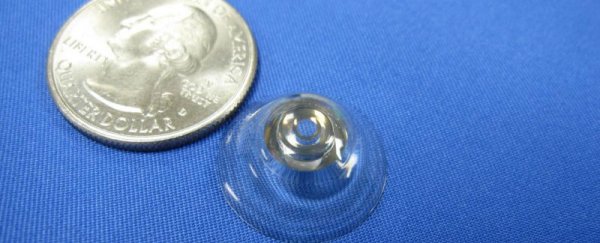An international team of researchers has unveiled a prototype contact lens that magnifies objects by 2.8 times, which could make things like road signs and facial features easier to detect for people with impaired vision.
If you don't already need contact lenses, imagine you did. Now, imagine that by winking while wearing said lenses, everything in your field of view suddenly grew to more than double its actual size. And all it took was another wink, with the opposite eye, to switch back to your normal vision.
It would be pretty cool to have telescopic powers on demand. But more importantly, contact lenses with this type of zoom-in capability could help the estimated 285 million people living with visual impairment around the world.
And fortunately, it seems the age of telescopic contact lenses might finally be here.
The lenses were shown off last week at the American Association for the Advancement of Science Annual Meeting in San Jose, California, and researchers say they will be most helpful for people living with age-related macular degeneration (AMD), which is one of the leading causes of vision impairment in adults over 40.
Age-related macular degeneration results from damage to the retina, and causes gradual vision loss and blurriness in straight-ahead sight, with lesser affects on peripheral vision. Researchers around the world have been working on new bionic vision systems, which could help restore a degree of sight in people with AMD, but these would likely require invasive surgeries.
"It's very important and hard to strike a balance between function and the social costs of wearing any kind of bulky visual device," said lead researcher and optical engineer Eric Tremblay, from the Swiss Federal Institute of Technology, in a press release. "There is a strong need for something more integrated, and a contact lens is an attractive direction. At this point this is still research, but we are hopeful it will eventually become a real option for people with AMD."
The lenses are about 1.55 mm thick and are made from a rigid material that covers the sclera, or white part of the eye, making them larger than most commercially available soft contact lenses.
According to the press release, they work by incorporating a very thin reflective telescope: "Small mirrors within bounce light around, expanding the perceived size of objects and magnifying the view, so it's like looking through low magnification binoculars."
Importantly, the lenses work in conjunction with a pair of electronic glasses, developed by the same team, which use a small light source and light detector to distinguish between a wink - which activates the zoom - and a blink.
As Aviva Rutkin explains for New Scientist, "A wink with one eye makes the glasses switch to a polarised filter that directs light to the telescopic part of the lenses. Winking with the other eye switches the setting back to let light pass through normally."
The contact lenses, which were funded by DARPA, were first showcased in 2013, but researchers have spent the last two years perfecting their "on-demand zoom" and making the lenses more breathable.
This last point is a critical challenge for all contact lens manufacturers, because the transparent tissues that make up the cornea are free of blood vessels, which means our eyes need to get their oxygen directly from the air.
To achieve better oxygen permeability, the researchers have incorporated tiny air channels about 0.1 mm thick within the lens. According to the press release, these channels allow "oxygen to flow around and underneath the complex and normally impermeable optical structures to get to the cornea".
As New Scientist reports, "the lenses have been tested on a life-size mechanical model of the eye that relays what is seen to a computer screen" but researchers are hoping to begin human trials as breathability improvements continue. Currently they can only be worn for about 30 minutes.
James Handa, an ophthalmologist at Johns Hopkins School of Medicine in the US told New Scientist the zoom lenses might be tricky to insert and take off for people who are visually impaired, but added that they could become a popular option.
"If it affords them the ability to get enough magnification for their loss of vision, absolutely," he said. "It's a highly innovative and very creative idea."
Interestingly, these aren't the only next-generation contact lenses being developed by DARPA. They are also working on a project to deliver virtual reality contact lenses, which would allow users to see small visual displays while still interacting with their physical environment.
Source: New Scientist
